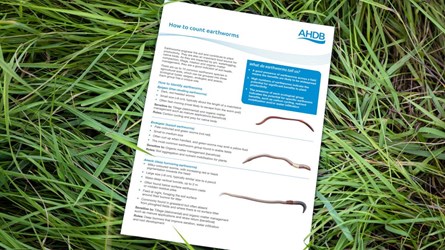- Home
- Knowledge library
- How to count earthworms
How to count earthworms
Counting earthworms is a simple method for assessing soil biological health
Earthworms are an indicator of soil health, being impacted by pH, waterlogging, compaction, tillage, rotation, and organic matter management.
Back to: Tests and indicators of soil health
Why are earthworms important?
Earthworms engineer the soil environment, help with carbon cycling, improve water infiltration and plant productivity, and are an important food source for native birds. They are also a biological indicator of soil health.
Counting earthworms
The best time to count earthworm populations is early in the spring, or after the soil has wetted up in the autumn.
Counting earthworms when it is warm and after rain often provides the best population estimates. Avoid taking samples when the soil is very dry. Soil should have been wet for a few days prior to sampling.
When assessing earthworm numbers, it is important to take more than one sample from within each field; 10 samples per field is ideal. Comparisons between cultivated parts of the field and margins can be useful.
Tools required
- Spade
- Pot Bottle of water
- Mat
- Earthworm identification guide
- Record and assessment sheet
Download the earthworm recording sheet
Step-by-step guide
- Dig out a soil pit (20cm x 20cm x 20cm) and place soil on mat
- Hand-sort the soil, placing each whole earthworm into the pot
- Count and record the total number of earthworms
- Separate earthworms into adults and juveniles
- Return juveniles to the soil pit
- Count and record the number of each type of adult earthworm
- Return earthworms to the soil pit and backfill with soil
- Repeat steps 1–7, until 10 soil pits per field have been assessed
Learn to identify earthworm types
How to identify adult earthworms
- Adult earthworms have a clearly developed saddle (reproductive ring, shown in the image below) and juveniles do not
- You may need to rinse earthworms with water to determine if a saddle is present
- Size is not a good indicator of maturity as adult earthworms typically range in size from 2cm to 15cm, depending on species
 highlighted.JPG) AHDB
AHDB
What do earthworms tell us?
- A good presence of earthworms across a field means the benefits are likely to be widespread
- High numbers of earthworms indicate the potential for significant benefits to plant productivity
- The presence of each ecological group indicates the potential for specific earthworm benefits, such as carbon cycling, nutrient mobilisation and/or water infiltration
Video: counting earthworms
Use the soil health scorecard
The soil health scorecard provides a framework to monitor soil health on a rotational basis.
The Excel-based tool uses soil analysis results for core soil health indicators and compares them to typical ranges for UK soil types and climate regions (benchmarks).
A completed scorecard automatically produces a 'traffic-light' snapshot of soil health to guide your management decisions.
Access the soil health scorecard
Further information
Topics:
Sectors:
Tags:


